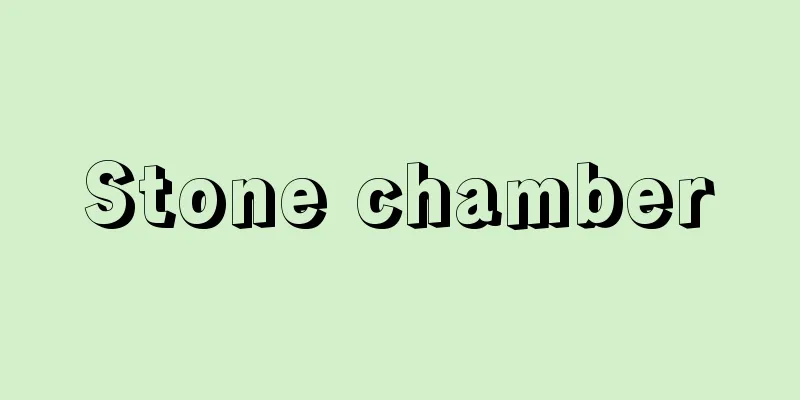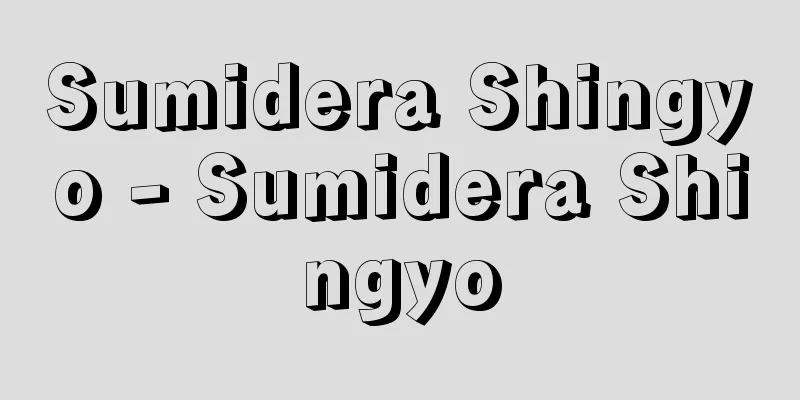Stone chamber

[1] 〘 noun 〙① A room formed between rocks or carved into a rock. Iwamuro (room for sleeping) or iwaya (room for sleeping). ※Bunka Shūreishū (818), Chō, Wa Musashi-hirokuji, May Visit to the Underworld Ruins, by Fujiwara no Fuyutsugu, “The wind is silent at the pine gate, the springs fly, the stone room is amazing.” ※Haiku poem, Oku no Hosomichi (c. 1693-94), Ungan-ji, “The passage through which Master Myō died is like the stone chamber of Master Houn.” 〔Shiji - Taishi Gong Ji Xu〕② A room in a building made of stone or concrete. Also, that building. [Wa-Ei Forest Collection (First Edition) (1867)] *Tokyo Shin Hanjo-ki (1874-76) <Hattori Seiichi> 3 "There is a stone chamber in the center of the garden, called the station. The pillars are inlaid with stones and the walls are polished, making it an exquisite and beautiful structure." 3. A stone burial chamber inside a tumulus that contains a coffin containing the corpse and grave goods. In the early and middle Kofun period (4th to 5th centuries), vertical stone chambers were built, but in the later period (6th to 7th centuries), under the influence of continental culture, horizontal stone chambers came to be used. 4. A library. *Shoreishu-5 (around 835) - The governor of Etsu Province asks for scriptures from within and outside Japan: "The stone chamber is difficult to see, the shell leaves are heard, the road is dangerous, and I have come to this conclusion" [Zhang Jiuling - A poem composed by the two Zhao attendants and the Western Army's former vassals] [2] A Rinzai sect monk from the Kamakura period to the early Muromachi period. His given name was Zenku. He was from Chikuzen (Fukuoka Prefecture). He traveled to Yuan and studied under Furubayashi Kiyomori. After returning to Japan, he lived at Nanzen-ji Temple and Tenryu-ji Temple, and later at the request of Ashikaga Motouji, he lived at Engaku-ji Temple and Kencho-ji Temple. He built the foundation for the rise of Gozan literature. Einin 2- Kōō 1 = Genchū 6 (1294-1389 )Ishi-muro [Stone chamber]Source: The Selected Edition of the Japanese Language Dictionary About the Selected Edition of the Japanese Language Dictionary Information |
[1] 〘名〙① 岩の間にできた、または岩をうがって造った室(むろ)。いわむろ。いわや。※文華秀麗集(818)中・和武蔵平録事五月訪幽人遺跡之作〈藤原冬嗣〉「風度松門寂、泉飛石室凄」※俳諧・奥の細道(1693‐94頃)雲岸寺「妙禅師の死関、法雲法師の石室をみるがごとし」 〔史記‐太史公自序〕② 石またはコンクリートで造った建物の部屋。また、その建物。〔和英語林集成(初版)(1867)〕※東京新繁昌記(1874‐76)〈服部誠一〉三「園の中央に石室有り、停車場と曰ふ。石を鏤めて而して柱と為し、石を磨ひて而して壁と為し、精巧美麗」③ 遺骸を入れた棺や副葬品を納めた、古墳内部の石の墓室。古墳時代の前期・中期(四~五世紀)には竪穴式石室がつくられたが、後期(六~七世紀)には大陸文化の影響により横穴式石室が採用されるようになった。④ 書庫。※性霊集‐五(835頃)与越州節度使求内外経書啓「石室難レ見、貝葉レ聞者、路険之所レ致也」 〔張九齢‐酬趙二侍御使西軍贈両省旧僚之作詩〕[2] 鎌倉時代から室町初期の臨済宗の僧。諱(いみな)は善玖。筑前(福岡県)の人。元に渡って古林清茂に学び、帰朝後、南禅寺・天龍寺、のち足利基氏に請われて円覚・建長両寺に住した。五山文学興隆の基礎を築いた。永仁二~康応元=元中六年(一二九四‐一三八九)
いし‐むろ【石室】出典 精選版 日本国語大辞典精選版 日本国語大辞典について 情報 |
<<: Red Cross - Sekijuji (English spelling) Red Cross
Recommend
abstrakte Collektiva (English spelling)
From this perspective, the state is also consider...
Minoshima
The central area of Arita City, northwest of Wak...
Odes funambulesques (English)
…French poet. He was an admirer of Gautier and so...
Zorrilla - José Zorrilla
Spanish poet and playwright. Born in Valladolid. ...
Axe of Vengeance
…In 1510 (the 5th year of the Zhengde era), the e...
Embedded bolt - Umekomi bolt
…After the war, the Japanese mountaineering world...
Libreville - Libreville (English spelling)
The capital of Gabon, in central Africa. It is lo...
Barium carbonate
Barium carbonate. It occurs naturally as witherit...
Osso Tounin - Osso Tounin
…Eventually, in 1264 (Bun'ei 1), an instituti...
Station place
...While the station building was an architectura...
Final rhyme - inbo (English spelling) final
A term from Chinese phonology. A Chinese syllable ...
Carmichael, Stokely
Born June 29, 1941 in Port of Spain, Trinidad and ...
Thermocolor
…A paint whose pigment is a compound that changes...
Kahada Gorge
A gorge in the upper reaches of the Kushida River ...
Lemon - Lemon (English spelling)
An evergreen fruit tree of the Rutaceae family (A...





![Nozawa Onsen [Village] - Nozawa Onsen](/upload/images/67cc7ab304d0d.webp)



